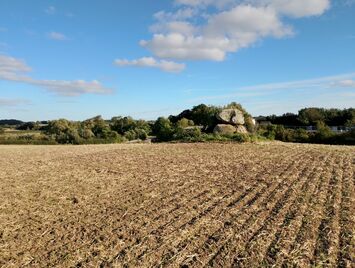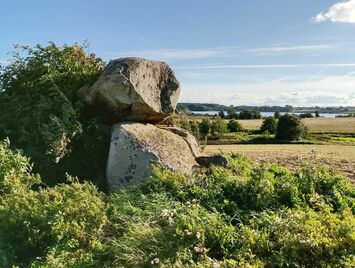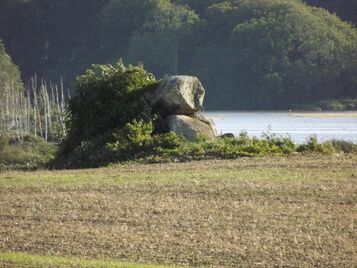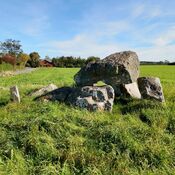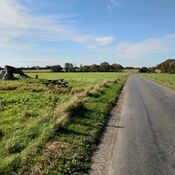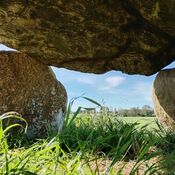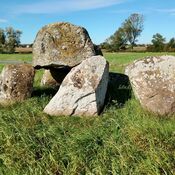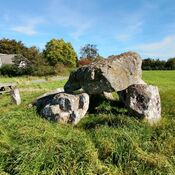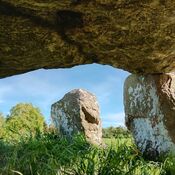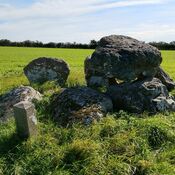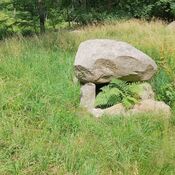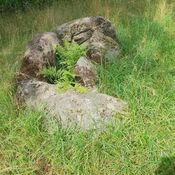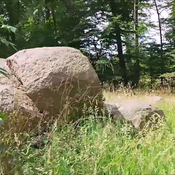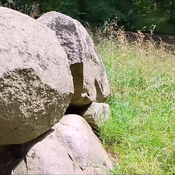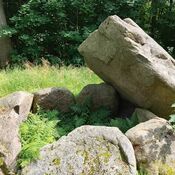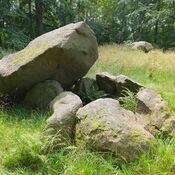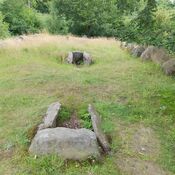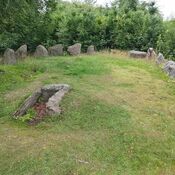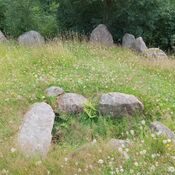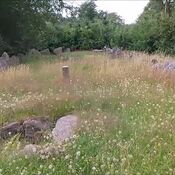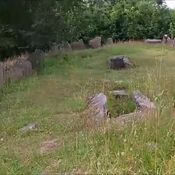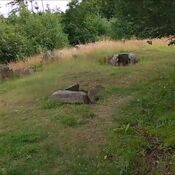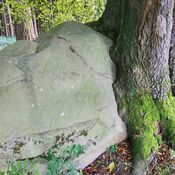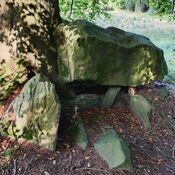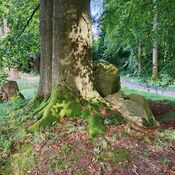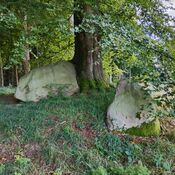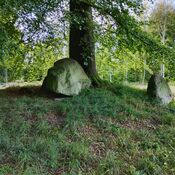The Vester Aaby Megalithic Tomb (Dysse) is a significant Neolithic burial monument situated on a field near Strandvejen in Vester Åby, Denmark. It is dated to the Stone Age, between 3950 and 2800 BCE, and is classified as either a round barrow or a dysse/passage grave, with grave goods from 3950-1700 BCE. The site has been protected (fredet) since before 1937 and is overseen by Arkæologi Sydfyn.
The monument features a free-standing, rectangular dysse chamber, oriented North-South. It is constructed from three support stones, one high threshold stone, and one capstone. A pair of larger boulders are positioned in front of the threshold stone. An 1885 survey described the chamber as 4 1/2 feet long and 3 1/3 feet wide at the entrance, with support stones approximately 6 feet wide at the base and 5 feet above ground. The capstone was noted as roughly square, about 6 feet on each side, and up to 5 feet thick.
A more recent 1988 survey provided internal measurements of 2.1 x 1.4 meters with a height of 1.3 meters, confirming the opening in the South. This survey also noted that the southern part of the large capstone had been broken off in ancient times. The remaining section is under threat, exhibiting several water-filled cracks and surface flaking, leading to concerns about frost cracking and a recommendation for a conservation assessment. The dysse includes a small remnant of an earth mound and was identified in 1988 as having been part of an East-West oriented long barrow, estimated to be 25-30 meters long, visible as a lighter fill with crushed flint in the surrounding ploughed field.
The site has been subject to multiple surveys by various national and local museums from 1874 to 2016. It is considered a beautiful and noteworthy dysse chamber, freestanding on a hilltop, and offers a splendid view over the meadows around Hundstrup Å. It is visible from a public road about 100 meters to the East.
www.kulturarv.dk/fundogfortidsminder/Lokalitet/8662/
www.youtube.com/watch?v=j-NkBgvAkXI
Locatie:
- Denemarken, Vester Åby
- geo:55.07605,10.374374
- Locatie precies
Period or year:
- -3000 / unknown
Classificatie:
- Graf (-veld)
- Zichtbaar
Identifiers:
- vici:place=101955
Annotaties
The Vester Aaby Megalithic Tomb (Dysse) is a significant Neolithic burial monument situated on a field near Strandvejen in Vester Åby, Denmark. It is dated to the Stone Age, between 3950 and 2800 BCE, and is classified as either a round barrow or a dysse/passage grave, with grave goods from 3950-1700 BCE. The site has been protected (fredet) since before 1937 and is overseen by Arkæologi Sydfyn.
The monument features a free-standing, rectangular dysse chamber, oriented North-South. It is constructed from three support stones, one high threshold stone, and one capstone. A pair of larger boulders are positioned in front of the threshold stone. An 1885 survey described the chamber as 4 1/2 feet long and 3 1/3 feet wide at the entrance, with support stones approximately 6 feet wide at the base and 5 feet above ground. The capstone was noted as roughly square, about 6 feet on each side, and up to 5 feet thick.
A more recent 1988 survey provided internal measurements of 2.1 x 1.4 meters with a height of 1.3 meters, confirming the opening in the South. This survey also noted that the southern part of the large capstone had been broken off in ancient times. The remaining section is under threat, exhibiting several water-filled cracks and surface flaking, leading to concerns about frost cracking and a recommendation for a conservation assessment. The dysse includes a small remnant of an earth mound and was identified in 1988 as having been part of an East-West oriented long barrow, estimated to be 25-30 meters long, visible as a lighter fill with crushed flint in the surrounding ploughed field.
The site has been subject to multiple surveys by various national and local museums from 1874 to 2016. It is considered a beautiful and noteworthy dysse chamber, freestanding on a hilltop, and offers a splendid view over the meadows around Hundstrup Å. It is visible from a public road about 100 meters to the East.
www.kulturarv.dk/fundogfortidsminder/Lokalitet/8662/
www.youtube.com/watch?v=j-NkBgvAkXI
In de buurt
Vester Skjerninge Jættestue (3 km)
Vester Skjerninge Jættestue
Den tredobbelte langdysse (syd) (5 km)
Den tredobbelte langdysse (syd)
Den store langdysse (5 km)
Long dolmen (langdysse)



